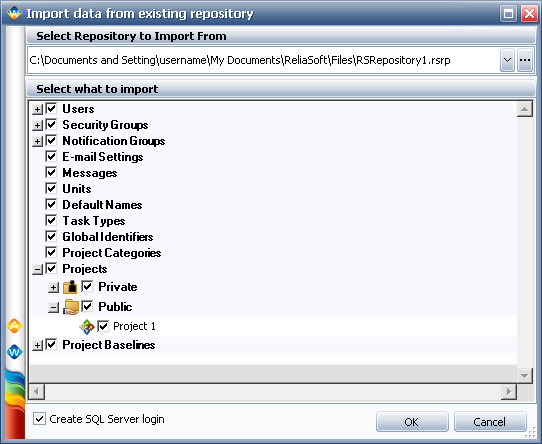![]()
![]()
| Related Topics: | ||
The Import Data from Existing Repository window allows you to import users, security groups and other database-level settings from an existing repository to a new standard database that you are in the process of creating. You can also import projects and other information. Note that to import data from a secure database, you need to have a valid user account in that database.
To use this window while creating a new database, choose File > New, then select the Import data from existing repository check box and click OK. If you wish to import to a database that you are currently connected to, you can use the Import/Export Wizard to import projects, project resources and project items.
When you select to import an existing repository, you will be asked to specify the name of the repository that you wish to import from, or you can browse for the repository. All available data in the selected database will be displayed in a list, and you will select the check box for each type of data that you wish to import into the new database. In addition, a + sign will be displayed next to each data type that has items that can be individually imported, as shown next.

For SQL Server databases, the Create SQL Server login check box will be displayed at the bottom of the window. Select the check box if you want to create an individual SQL Server login when you create each new Synthesis user account. The SQL Server login will be created if a login does not already exist for the username and if you have the appropriate authority in SQL Server to create logins. If you clear this check box, the user can still be recognized by SQL Server if a) an individual SQL Server login was created in advance in SQL Server, b) the user belongs to an Active Directory group that has a SQL Server login shared by all members of the group or c) the user connects to the repository with an enterprise connection file (*.rserp) that impersonates another Windows user account that has a SQL Server login. See SQL Server Logins or Using Windows Impersonation.
© 1992-2013. ReliaSoft Corporation. ALL RIGHTS RESERVED.